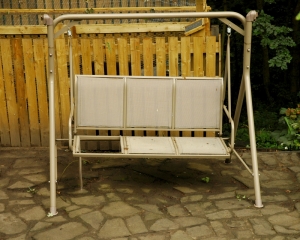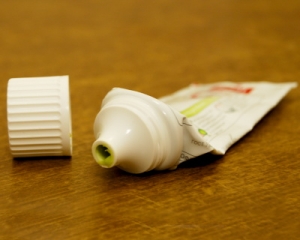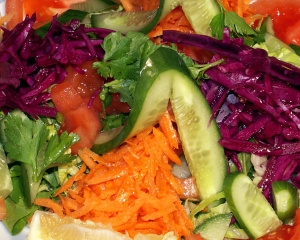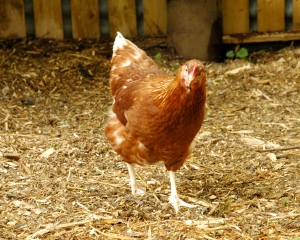Making our pets zero waste: the dog
A couple of weeks ago, I wrote about drying ox heart and other offal to make dog treats for our springer spaniel, Lily.
We adopted Lily from the Dogs Trust in March and she very quickly made herself a core member of the household – and here, that means being green and frugal :)
Food
As first time dog owners, we accepted the Dogs Trust’s recommendation of a certain type of dry food, with water – or whey or gravy, when they were available. Following feeding advice online, I tried feeding her veggies too – mixing them in with her food or giving them to her like a treat – she politely took them, because she’s a very polite well-mannered dog, but then gently dropped them to the floor and gave me a look. If you have animals/children/beloveds who you regularly try to deceive and betray by handing them a carrot when they expect beef, you know that look.
So, anyway, her food is very low waste: the dry food comes in giant paper sacks = recyclable. And because it’s biscuits, they don’t go off like meat does, so there is no food waste.
Read MoreHomemade dog treats: drying offal in a dehydrator
In the supermarket a couple of months ago, John noticed that the dog treats we were buying our old springer spaniel Lily cost £11 a kilogram. The prepackaged lumps of cereals, additives and mechanically recovered meat were more expensive gram for gram than cheese, steak or a nice roast. That didn’t seem quite right to us.
We swapped to using cheese for a while – mostly because it kept longer than meat – but Lily wasn’t that keen so we decided to try making some homemade dog treats by dehydrating some meat instead: it would last longer than cheese and wouldn’t need refrigeration.
Read MoreBad Buys: the garden swing
This will be an occasional series of posts documenting my worst buys over the years and why they were a mistake. I hope it’ll help me – and other people – learn from my mistakes.
When we moved into our new house last autumn, there was an old garden swing cemented into the patio in the garden. My mum and dad had a similar swing for a few years when I was a kid – a white metal tube frame with big puffy plastic-coated cushions – and according to our photo albums, our family lived on it in the summer. John wasn’t keen on the swing here though because it looked rickety, somewhat knackered and in white, stood out against the natural colours of our garden – but I thought we might as well use it since it was there. Maybe play up the retro – brighten up the white & cover the dated floral cushions with a red polka dot design. It was put on the list for “things to do over the summer” and forgotten about.
Then a (used) swing popped up on my “around here and cheap” eBay search. In a mushroom-y beige colour, it wouldn’t stand out so much, it looked more solid and best of all, it was more practical because the seats were the plastic mesh, meaning we could use it without having to climb two flights of stairs to get the cushions. It was £30 and only a short drive away. We ‘bought it then’. At no point did we ask ourselves whether we actually wanted a swing – we were just hell-bent on replacing the old one with a better one than the one we had.
Read MoreUsing the last of everything: how do you do it?
This is cross-posted to my reusing & recycling blog, Recycle This, in its ‘Reduce This‘ category.
I’ve reached the end … of my shampoo bottle and our mayonnaise jar. And it made me wonder…
Every vaguely-frugal family has their own tricks for getting those last bits of gloop, sauce, oil or whatever out of jars and bottles – but what are your top tips?
Most bottles – from condiments to shampoo – are easily emptied by standing them upside down for a few hours.
Cooking sauces – jars/cans of tomatoes – are easy too: a little squish of water around to pull off the last of the sauce/juice then into the pan it goes to be reduced off.
Cooking oils bottles and jams & honey jars get left in a bowl of hot water to make the remaining contents a little runny and easier to pour out.
Metal squeezy tubes – like tomato puree and old school toothpaste – can be rolled up and squeezed, but the new plastic toothpaste tubes aren’t so rollable – cutting them open seems the only option.
What other methods do you use?
Read MoreBig portions vs food waste: a dilemma
While going about our chores, we had lunch in Saltaire on Saturday. We only wanted something light so got sandwiches – but when they arrived, the plates piled high with food – enormous sandwiches, stacks of salad and a generous portion of homemade coleslaw. It’s not often we’re overfaced by food portions but it happened there.
Big portions are obviously good from a being-cheap point of view – if we go back there again, we’ll half the cost by sharing and still probably have enough to eat – and people feel better about paying the (frankly quite expense) prices if they get so much food they can’t eat it. But we both ended up leaving food. Since they were covered in salad dressing and sandwich fillings, the stuff we left probably won’t be composted (if the cafe composts their leftovers at all) so our meal generated food waste that will be sent to landfill.
I like food and I like getting as much for my money as possible but I don’t like stuff going to waste. I might have been happy as a frugal bunny but sad as a waste-reducing greenie.
Has anyone been in a similar situation? Any advice? Where does your preference lie – in perceived value for money or minimal waste?
Read MoreEconomics of having chickens: getting started
After 18 months of waiting, we *finally* got some chickens on Tuesday. This post is the first in what I imagine will be an occasional series about the economics of having chickens.
Despite my tight-fisted frugal heart, having chickens at home isn’t about getting cheap eggs. It’s about getting good eggs from well treated and well fed chickens. It’s about food metres and not food miles. It’s about using up an otherwise hard to make productive bit of ground. It’s about introducing more diversity into our garden and harvesting poop for fertiliser. And it’s about living with some fascinating pseudo-dinosaurs – learning about them, looking after them and laughing at them because they’re such fun, odd things. But while those things are almost priceless, they do have a price.
Back when I first got giddy about the idea of having chickens, I read a great page about the economics of having chickens – breaking it down to the cost per egg over the first year (when there are higher capital costs but potentially high egg production) and in future years (smaller capital cost, slowing egg production etc). It was great – but can I find it now? No. I hate Google sometimes. But I’m going to work out something similar for myself and this post is the first stage of that.
Read More








